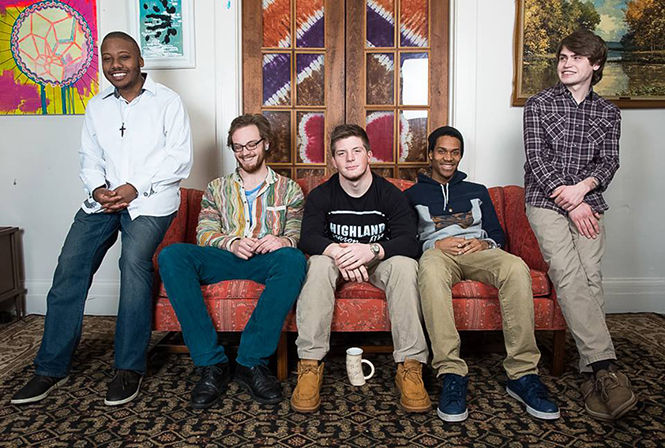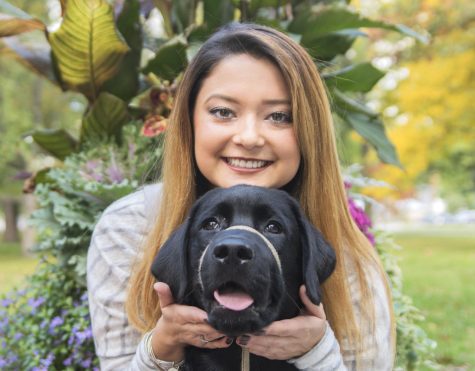Acidic jazz with a romping groove
December 2, 2014
During a recent Acid Cats performance at the Stone Tavern, the five-piece closed its hour-long set with a vibrant version of “When the Saints Go Marching In.” Justin Tibbs, donning aviators, tilted the bell of his sax to the ceiling in unison with trumpet player Tommy Lehman. The whole tavern sung along with Lehman as he belted the famous, melodious chorus, tearing the house down via the group’s harmonious groove.
A typical Cats show, to say the least.
One of Akron’s most promising new jazz fusion groups in the last few years, the Acid Cats are set to play Akron’s Musica on Friday, Dec. 5, at 9 p.m., backing up their friends Jovan Wilder and the Wild Things. With a new album, “All in a Day’s Work,” underway, the Acid Cats are ready to flaunt their new voice and sound — featuring a lineup of Lehman-led backup singers, rappers and a fresh assortment of song arrangements.
“We’re trying to create some unity and some full compositions,” said bassist Zachary Wolfe Nagi-Schehl. “We’re trying to be a little more well-rounded.”
With a little more than a year since the release their first album, “Crosby Street,” in 2013, the Acid Cats have catapulted from a traditional, jazz-club combo to a romping quintet. Nagi-Schehl said it seemed like a quick transition. He first teamed up with guitarist Michael Vincent when the two attended the University of Akron, when the two were avid worshippers of John McLaughlin’s Mahavishnu Orchestra. They needed another Cat to play drums, so Cameron Bickley, a sophomore at Kent State, was brought in and Lehman followed. Their Mahavishnu-like EP came shortly afterwards.
The then-quartet spent around three months experimenting with “acidic jazz,” a musical lineage that extends back to the eccentric Sun Ra, the legendary Jaco Pastorius and guitar pioneer Pat Metheny. Nagi-Schehl said Led Zeppelin also found its way into making the Cats what they are. Yet it wasn’t until Tibbs was brought in that the Cats morphed into their current formation, now, more comfortable in their skin than ever before, Lehman said.
“It’s almost evolved into finding our own voice, as influenced by our community, and what’s hip to us right now,” he said.
What’s hip to Lehman and the rest shines through in their latest sound: Lehman’s confident, R&B vocals, ripe with love-torn lyrics; Vincent’s bumping, genre-blending leads; Nagi-Schehl and Bickley’s incessant rhythmic fuel. The added power of the human voice, adds a more textured Cats sound, representative of their current mindset. The only thing the Cats seemed to be missing is a full-on orchestra, Lehman said.
But the togetherness seen and heard in a Cats show doesn’t come easy. Vincent is known to be a practice-holic, shutting himself in isolation for several hours a day. Other than the two-day-a-week mandatory band practice, the Acid Cats are a close-knit collective, and are often known to spend holidays and birthdays together, even attending church service on Sundays. All of their recordings, Nagi-Schehl said, are live-tracked in one single room for this very reason.
“It’s about listening and hearing one another, trying to fit it together,” he said. “We each kind of have our own place, and it shows when we play.”
And for a very good reason.
“So hopefully it all kind of pours out naturally,” Nagi-Schehl said.
Along with the Akron, Cleveland and Canton bar gigs, the Cats have adapted their fusion to banquet halls, weddings and high-class restaurants. They even played a more tame gig at the St. John-Paul Lutheran Church in Akron earlier this year, proving that there is no venue too righteous for the five-piece’s acidic jazz rock.
Yet with the newest incarnation of the Acid Cats, longtime fans and Cats virgins alike can readily hop onto the groove that Lehman and tribe have been putting out since the start. Cats staples like “Jive Talk” or “Night in Brooklyn,” move feet and legs so freely for a reason, Lehman said.
“At the end of the day this music was created for dancers,” he said. “I think that’s the point: having that groove. It’s definitely the foundation of most of our music — which is having people tap their feet.”
And the group affirms this claim well enough, leaving any need for classification at the bar room door. To paraphrase Duke Ellington: Jazz is a good measure of freedom, and the Cats can sure affirm this well enough.
Nagi-Schehl said he feels they should go one step further for definition’s sake, in a Socratic sense.
“The real question is, however, ‘What is jazz?” he said.
Is it the Acid Cats?
“Well, it’s whatever you want it to be,” he said. “That’s what’s cool about it.”
Contact Mark at [email protected].























